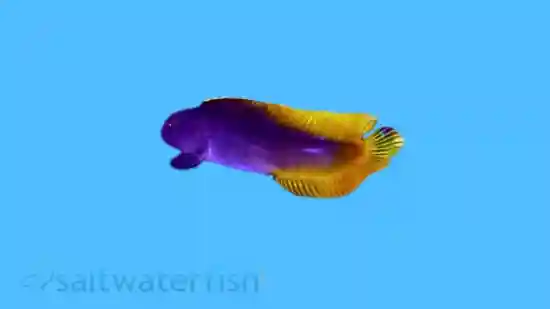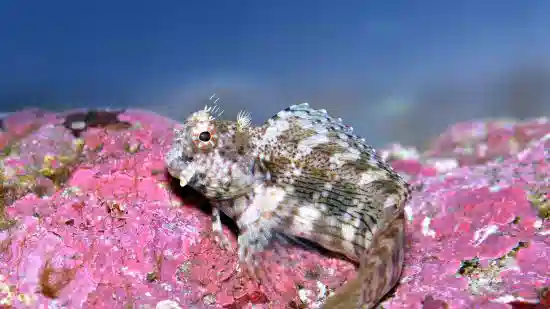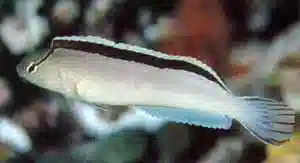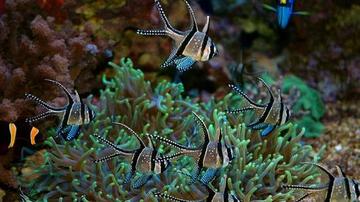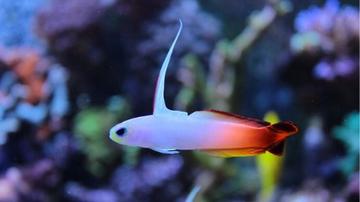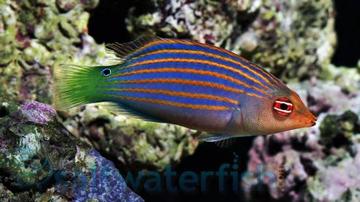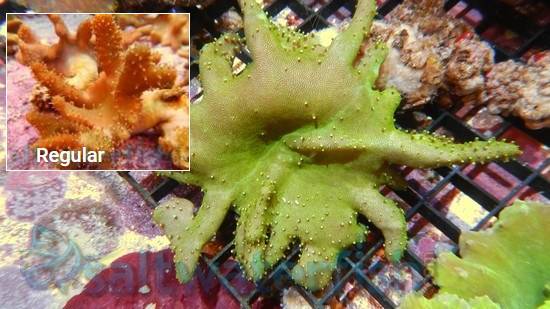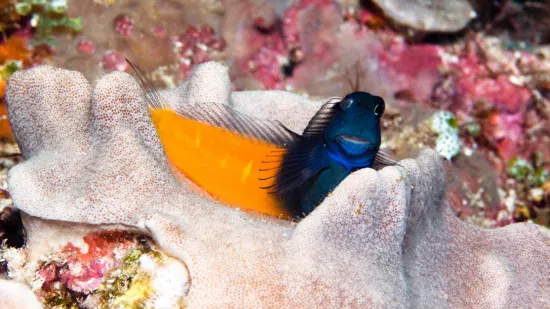Bicolor Blenny
Ecsenius bicolor
(51 Reviews)
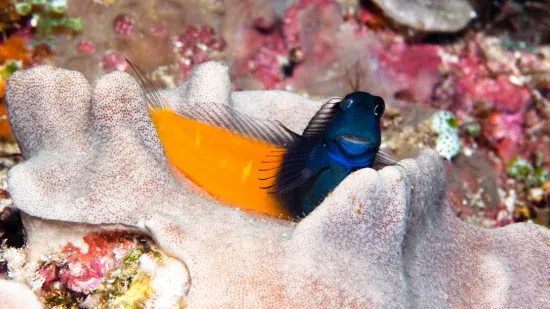
Bicolor Blenny
Ecsenius bicolor
(51 Reviews)
{{ item.name }}
Size: {{ item.extra_field_3 }}
${{ getFormattedPrice(item.saleprice) }} ${{ getFormattedPrice(item.price) }}
To join the waiting list, click here
Free Shipping
With
$199.00
or more in Marine Life.
More details...
Bicolor Blenny Care Facts
| Care Level: | Easy |
|---|---|
| Temperament: | Peaceful |
| Diet: | Herbivore |
| Reef Safe: | Yes |
| Minimum Tank Size: | 30 gallons |
| Max Size: | 4 inches |
Bicolor Blenny (Ecsenius bicolor): A Comprehensive Description for Saltwater Marine Aquariums
Habitat of the Bicolor Blenny
Native to the Western Pacific Ocean, the Bicolor Blenny is commonly found in coral reefs, rocky areas, and lagoons, preferring environments with plenty of crevices and hiding spots among live rock.
Is the Bicolor Blenny Reef Safe?
The Bicolor Blenny is generally considered reef safe, as it doesn't threaten corals or other invertebrates within the aquarium. However, it's essential to ensure no aggressive tank mates might harass the blenny.
Size of the Bicolor Blenny
With a size ranging from 3 to 4 inches (7.5 to 10 cm), the Bicolor Blenny is a relatively small species, making it suitable for a range of aquarium sizes.
How Long Does the Bicolor Blenny Live?
Under proper care, Bicolor Blennies can live for approximately 2 to 4 years, providing aquarists with an engaging and relatively long-lasting marine inhabitant.
What To Feed the Bicolor Blenny?
Bicolor Blennies are omnivorous, requiring a diet that includes high-quality marine flakes, pellets, and small meaty foods such as brine shrimp and mysis shrimp. A varied diet helps maintain their health and vitality.
Aquaculture Availability of the Bicolor Blenny
Aquacultured Bicolor Blennies are occasionally available in the hobbyist market, reflecting the advancements in captive breeding and sustainable marine practices. Absent aquacultured specimens, choose wild-caught from a responsible supplier.
Compatibility of the Bicolor Blenny
Bicolor Blennies have a peaceful temperament and can coexist with various tank mates, especially those that are not aggressive or territorial.
Personality of the Bicolor Blenny
Known for their amusing and active behavior, Bicolor Blennies are entertaining to observe as they dart in and out of crevices and explore their environment.
Suitable Tank Mates for the Bicolor Blenny
- Firefish Goby (Nemateleotris magnifica): A non-aggressive species that adds movement and visual interest to the tank.
- Yellowtail Damsel (Chrysiptera parasema): A hardy and colorful fish that generally gets along with Bicolor Blennies.
- Cleaner Shrimp (Lysmata amboinensis): Known for their cleaning behavior, these shrimp can coexist with the blenny.
- Royal Gramma (Gramma loreto): A peaceful fish occupying a different aquarium level, complementing the blenny's habits.
- Coral Banded Shrimp (Stenopus hispidus): A compatible shrimp species that adds diversity to the tank.
It's important to note that the compatibility of tankmates can vary based on individual fish personalities, tank size, and the specific setup. Before introducing any new fish to your aquarium, thorough research and careful observation are essential to ensure the well-being of all inhabitants. Additionally, providing plenty of hiding spots, creating a diverse environment, and closely monitoring interactions can help reduce potential conflicts among tankmates.
Tank Requirements for the Bicolor Blenny
Minimum Aquarium Size: A tank with a capacity of 30 gallons or more is suitable for housing a Bicolor Blenny.
Aquascaping: Provide ample live rock with crevices and hiding spots to mimic their natural habitat and offer exploration opportunities.
Ideal Water Conditions for the Bicolor Blenny
- pH: Maintain the pH level between 8.1 and 8.4.
- Salinity: Keep the salinity within the range of 1.023 to 1.025.
- Water Temperature: The recommended temperature range is 72°F to 78°F (22°C to 26°C).
- Water Flow: A gentle to moderate water flow is preferable, simulating their native environment.
Other Common Names for the Bicolor Blenny
The Bicolor Blenny might also be known as the Two-colored Blenny.
Why Choose Bicolor Blennies from Saltwaterfish.com
When selecting Bicolor Blennies from Saltwaterfish.com, you choose an engaging and visually appealing addition to your saltwater marine aquarium. Our commitment to sourcing healthy and responsibly collected specimens ensures you receive vibrant and well-adapted fish for your aquatic environment. With our extensive experience and dedication to marine life, Saltwaterfish.com is a trustworthy source for enthusiasts seeking quality marine species.
The Bicolor Blenny's distinct attributes and compatibility make it a valuable choice for your saltwater marine aquarium. By adhering to their specific care requirements and creating an environment that caters to their needs, you can enjoy the activity and visual interest this captivating marine inhabitant brings to your tank.
Doing good
Reviewed by: David Harris on June 4, 2025
Reviewed by: Georgette Sullivan on April 7, 2025
Beautiful and just as pictured with vibrant colors.
Reviewed by: Natalia Szawranskyj Stuart on March 13, 2025
Reviewed by: Brice Butterfield on Feb. 2, 2025
Reviewed by: Thomas Knott on Dec. 7, 2024
Reviewed by: Connie Kellaher on Nov. 27, 2024
Exactly as described
Reviewed by: Scott Olson on Oct. 9, 2024
Made a rock its home and seems to be doing fine
Reviewed by: Jose Lara on Sept. 15, 2024
Reviewed by: Gary Sparks on Sept. 10, 2024
Reviewed by: Quynh Nguyen on Aug. 6, 2024
Reviewed by: Michael Thomas on July 21, 2024
Reviewed by: Neil Manack on July 17, 2024
My favorite of them all! The cutest thing ever!
Reviewed by: Pamela Alejandre on July 14, 2024
Reviewed by: Debbie Konechney on June 30, 2024
Reviewed by: Jared Estes on June 25, 2024
Reviewed by: Drake Scott on June 24, 2024
Reviewed by: Brian Halsey on June 23, 2024
Another survivor from 2 day shipping due to delay and he's doing fantastic.. Cool personality.
Reviewed by: Greg Kelso on June 19, 2024
Reviewed by: Francene Livingston on June 10, 2024
Great personality
Reviewed by: Anthony Little on June 4, 2024
Reviewed by: Gary Sparks on June 3, 2024
Doing wonderfully!!
Reviewed by: Jody Stivers on June 1, 2024
Very active
Reviewed by: Billy Springer on May 22, 2024
Cute little guy
Reviewed by: Maria Robles on April 17, 2024
Love this fish very healthy and playful
Reviewed by: Maria Robles on April 12, 2024
Awesome personality love the Bicolor Blenny.
Reviewed by: Ramon Otero on April 11, 2024
Reviewed by: Justin Leeper on April 9, 2024
Reviewed by: Bryan Kaufman on April 9, 2024
Reviewed by: Cameron Kreger on March 17, 2024
Reviewed by: Joshua Staats on March 3, 2024
Reviewed by: Trevor Cavanaugh on Feb. 15, 2024
Loved to dart in and out of many
Reviewed by: Alvin Barbes on Feb. 14, 2024
Love personality my son’s favorite
Reviewed by: Anthony Little on Feb. 1, 2024
Great color
Reviewed by: Mike Perdue on Jan. 30, 2024
They disappear for awhile
Reviewed by: Alvin Barbes on Jan. 30, 2024
Liked the scooter blenny that I put a bi color blenny in my other tank. It’s great to see him when he comes out but understand, they like to hide. He found a particular hole in one of my rocks and hides there all the time. I know exactly where he is at because I see his head sticking out of the hole.
Reviewed by: Dale Pichelmayer on Jan. 29, 2024
Reviewed by: Lynn Adams on Dec. 13, 2023
Reviewed by: Marcos Quiros on Dec. 10, 2023
Reviewed by: Andrew Zadrejko on Nov. 23, 2023
Good pretty fish
Reviewed by: Charles Felt on Nov. 19, 2023
Reviewed by: Nick Direnzo on Nov. 12, 2023
He’s fun to watch.
Reviewed by: Dinah Martin on Nov. 6, 2023
Reviewed by: Dustin Johnson on Nov. 1, 2023
So far doing well in qt
Reviewed by: Jim Sharpe on Oct. 8, 2023
Just chilling ????
Reviewed by: John Stone on Sept. 17, 2023
Reviewed by: Susan Alexandre on July 24, 2023
Little shy at first but Eating great now.
Reviewed by: Donald Roman on July 13, 2023
The blenny was in great shape when he showed up and Ive had him for 6 months. But I thought I was killing off my 2 Acan colonies but after a few days of observation my blenny was eating them, kinda look like what a lawnmower blenny does to algee. Moved him to my sons FOT. There not always reef safe.
Reviewed by: Darrin on April 23, 2018
Love these little fish. They have so much personality, they are very feisty little fish. Love how they stick up for themselves. Once they have established their territory they defend it to the max. No they are not aggressive, just stick up for themselves
Reviewed by: James Fisher on July 24, 2016
Very healthy fish, eating well.
Reviewed by: Trisha on July 2, 2016
I absolutely love the Bicolor Blenny. They perch in holes in the live rock. If you get them at the right angle their face seems to have spots that light up with the antenaes and mouth. Gives it a very cool look. Mine seems to have found a home under my Zoas and actually protects the Zoas when other fish or crabs get near.
Reviewed by: Jennifer Mckinney on Aug. 4, 2014



